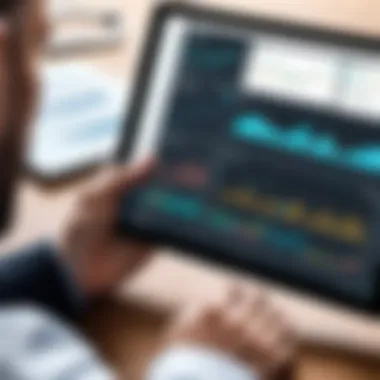Enhancing Asset Management with Stand-Alone Software


Intro
Asset management is a critical aspect in today's fast-paced business environment. Efficient handling of fixed assets can lead to significant cost savings and improved compliance with regulatory frameworks. The integration of technology into this practice is vital, and stand-alone fixed asset software plays a key role.
This article delves into stand-alone fixed asset software, detailing its design, functionalities, and the benefits it brings to asset management. Also, we will cover the challenges faced by organizations in this area, and important factors for selecting the right software. Decision-makers and IT professionals can gain insights from this examination to enhance their asset management practices.
Overview of Core Features
Stand-alone fixed asset software offers a range of functionalities essential for streamlined asset management. Organizations can leverage these tools to manage their assets effectively, ensuring accurate reporting and compliance with relevant regulations. Key features include:
- Asset Tracking: Maintain real-time visibility of asset location and condition.
- Depreciation Management: Automate depreciation calculations based on different methods like straight-line or declining balance.
- Inventory Management: Tracking and managing spare parts and associated costs for each asset.
- Reporting Features: Generate detailed reports for financial statements, audits, and inspections.
- Compliance Tracking: Ensure adherence to regulatory standards and guidelines.
- Integration Capabilities: Seamless collaboration with existing financial systems like QuickBooks or SAP.
When comparing various fixed asset software options, certain providers like Sage Fixed Assets, Asset Panda, or Oracle NetSuite stand out due to their robust feature sets. Each software offers distinct functionalities that cater to various business needs, which can be critical when selecting a suitable solution.
User Experience and Interface
An often-overlooked aspect of software choice is the user experience and interface. An intuitive design can significantly impact usability:
- UI/UX Design Aspects: Modern software interfaces often emphasize simplicity while retaining powerful functionalities. Effective design allows users to navigate the system without extensive training, allowing quicker integration into daily operations.
- Usability and Accessibility: The importance of a user-friendly interface cannot be overstated. Streamlined workflows enhance productivity and reduce the time spent on asset management tasks.
Accessibility is equally important as it ensures that users with different abilities can utilize the software without barriers.
"Usability and thoughtful design facilitate smoother operations and empower users in their asset management roles."
Considering all necessary features and the user experience is essential during the selection process. A well-chosen software solution can significantly improve an organization's asset management processes and overall efficiency.
Foreword to Stand-Alone Fixed Asset Software
The management of fixed assets is a crucial component in any organization's financial strategy. Stand-alone fixed asset software serves as an invaluable tool to facilitate this management, driving efficiency and accuracy within asset tracking and reporting processes. Understanding the purpose and significance of this software is paramount in recognizing its role in optimizing overall asset management.
Definition and Purpose
Stand-alone fixed asset software is designed to handle various aspects of asset management independently from other financial systems. Its primary purpose is to provide organizations with a dedicated platform that addresses the complexities of tracking, depreciating, and reporting on fixed assets. This software allows companies to automate asset-related processes, thus reducing the manual effort required, minimizing errors, and ensuring compliance with accounting standards. It enables decision-makers to manage the lifecycle of assets more effectively, from acquisition through disposal.
By utilizing such software, organizations can make informed financial decisions, understand the value of their assets, and adhere to regulatory requirements. The software typically integrates functionalities such as asset tracking, maintenance scheduling, and depreciation management, fostering enhanced oversight and control.
Market Trends in Asset Management Software
The landscape of asset management software is evolving rapidly, influenced by advancements in technology and changing market needs. One notable trend is the increasing pivot toward cloud-based solutions, which offer flexibility, scalability, and real-time data access. Organizations prefer such platforms as they reduce upfront investment and maintenance costs.
Furthermore, integration capabilities with other enterprise software are becoming essential. Companies look for solutions that can easily connect with their existing systems, allowing for seamless data exchange. This connectivity not only enhances usability but also improves overall financial visibility.
Another trend is the incorporation of advanced analytics and reporting features within asset management software. With the ability to analyze asset performance and maintenance needs, organizations can better allocate resources and optimize their asset utilization.
"The shift towards automation and predictive analytics is reshaping how organizations approach asset management."
The demand for enhanced compliance tracking mechanisms is also notable. As regulatory standards become increasingly stringent, organizations require software solutions that can provide accurate reporting and documentation to navigate audits and compliance checks successfully. In essence, stand-alone fixed asset software is not just a tool; it is a strategic asset that can drive organizational success and efficiency.
Key Features of Stand-Alone Fixed Asset Software
The significance of key features in stand-alone fixed asset software cannot be overstated. These features directly influence how efficiently organizations manage their assets, maintain their financial records, and comply with various regulations. By understanding these features, decision-makers can make informed choices that align with their organizational goals. The right software effectively addresses common challenges, enhances accuracy, and improves operational performance.
Asset Tracking and Maintenance Scheduling
Asset tracking is a critical function that helps organizations maintain visibility over their physical assets and their conditions. It allows businesses to monitor inventory levels, asset usage, and locations. With real-time data, organizations can optimize resource allocation and make informed strategic decisions.
Maintenance scheduling complements tracking by ensuring that assets receive timely upkeep. Scheduled maintenance reduces downtime and extends the lifecycle of assets. This feature minimizes unexpected repair costs, which can significantly impact an organization's bottom line. Software such as Sage Fixed Assets or FORMULAW can provide these capabilities, making asset management seamless.


Depreciation Management
Depreciation management is another essential feature of stand-alone fixed asset software. It automates the calculation of asset depreciation, providing accurate financial reporting. Understanding depreciation assists companies in recognizing the true value of their assets over time. This feature often ensures compliance with accounting standards and tax regulations, which is crucial for avoiding penalties. Software options like Asset Panda and NetSuite offer comprehensive depreciation management tools, which simplify the complexities involved in fiscal auditing and reporting.
Integration Capabilities
Integration capabilities of fixed asset software are vital for ensuring a cohesive operational framework. Organizations often utilize multiple systems, including accounting, ERP, and supply chain platforms. The ability to seamlessly integrate fixed asset software with these existing systems enhances the flow of information across the organization. This integration minimizes data silos and promotes accuracy in reporting. Each data entry is reflected across all platforms, reducing errors and time consumption. Companies should prioritize software that provides robust API support or direct integration tools. Applications like SAP and QuickBooks often excel in this area, allowing for smoother operations and comprehensive data analysis.
"Choosing software with strong integration capabilities ensures that your asset management processes are both efficient and reliable."
In summary, understanding the key features of stand-alone fixed asset software provides a roadmap for organizations looking to improve their asset management practices. Each feature serves a unique purpose, contributing to overall operational excellence.
Benefits of Using Stand-Alone Fixed Asset Software
The implementation of stand-alone fixed asset software offers numerous advantages that significantly enhance asset management practices. Organizations leverage these benefits to foster better financial reporting, maintain regulatory compliance, and optimize resources effectively. As businesses face increasing scrutiny regarding financial transparency and efficiency, the role of this software becomes more pronounced.
Improved Accuracy in Financial Reporting
One of the primary benefits of stand-alone fixed asset software is the improvement in accuracy for financial reporting. The software automates calculations for asset valuation, depreciation, and amortization, which minimizes human error. It enables finance teams to present information that is not only precise but also timely.
This accuracy helps build trust with stakeholders. For instance, asset misreporting can lead to significant financial penalties and affect the company’s reputation negatively. With accurate asset reporting, decision-makers can evaluate the financial health of the organization more effectively.
- Real-time Data Access: Users can access current asset information, ensuring that the financial data reflects the latest status.
- Customizable Reporting: Many software solutions allow for tailored report formats that meet specific organizational needs or regulatory requirements.
Enhanced Compliance and Risk Management
Compliance is another crucial area where stand-alone fixed asset software shines. Many industries are governed by strict regulations requiring detailed reporting and asset tracking. Investing in such software can facilitate adherence to these regulations.
This software assists in monitoring compliance with local and international standards, thus reducing risks associated with audits or penalties. For example, tools within the software enable tracking of asset disposal and acquisition as per regulatory guidelines, which is vital for accurate reporting.
Regular updates and compliance features within the software ensure that organizations remain ahead of changing regulations. Companies can benefit from:
- Audit Trails: Providing clear records make audits smoother and more efficient.
- Notifications for Regulatory Changes: Alerts for changes in compliance regulations help organizations adjust accordingly.
Cost Efficiency and Resource Optimization
Finally, the use of stand-alone fixed asset software can lead to significant cost savings and resource optimization. Over time, an automated system can free up valuable personnel hours. This allows financial staff to shift focus from mundane tasks to strategic analysis and planning.
Moreover, the software's insights allow organizations to track asset utilization effectively. This means that unnecessary purchases can be avoided, leading to better financial management over time.
Benefits include:
- Reduction in Operational Costs: Streamlined processes translate to lower costs.
- Improved Resource Allocation: Better tracking helps in allocating resources where they are most needed.
"Integrating stand-alone fixed asset software can transform not just the asset management process but also the overall financial efficiency of an organization."
Challenges Associated with Stand-Alone Fixed Asset Software
Implementing stand-alone fixed asset software can provide substantial advantages for asset management. However, it is also important to recognize the challenges that organizations may face during this transition. Understanding these issues is essential for decision-makers and IT professionals to navigate the complexities involved in successful adoption.
Integration Issues with Existing Systems
One of the most significant challenges of stand-alone fixed asset software is integration with existing systems. Many organizations utilize various software solutions for finance, operations, and inventory management. The lack of seamless integration can lead to data silos, where information becomes isolated and inaccessible across different departments.
Integration issues can also create discrepancies in data recording and reporting. This might lead to errors in asset valuation or misreporting of financial statements. Furthermore, they can result in increased workloads for employees, who must manually reconcile discrepancies between systems.
Addressing this challenge often requires thorough planning and assessment of the current IT infrastructure. Organizations need to evaluate how new software will fit into their existing processes. This transition often involves a customized approach, including the development of APIs or connectors to facilitate smooth data exchange.


In some cases, organizations might need to consider software solutions that offer robust integration capabilities. This can mitigate the risk of misalignment and enhance overall operational efficiency.
User Adoption and Training Requirements
Another critical barrier is user adoption. Even the most advanced stand-alone fixed asset software will not deliver its full potential if employees are not uing it effectively. Resistance to change can arise for various reasons, including unfamiliarity with the new system or a lack of perceived benefits.
To overcome these hurdles, organizations must invest in comprehensive training programs. This training should not only cover the technical aspects of the software but also emphasize its practical applications in everyday work processes. By providing users with a clear understanding of how the software improves their workflow, organizations can foster a more positive attitude toward the new technology.
Conducting training sessions, both in-person and online, can help address different learning styles. Additionally, creating support resources, such as quick reference guides or video tutorials, will further assist staff in transitioning smoothly.
Engaging employees through feedback and discussions can also enhance adoption rates. This involvement encourages a sense of ownership over the new system and underscores its importance in achieving the organization's broader goals.
Costs of Implementation and Maintenance
Finally, the costs associated with implementing and maintaining stand-alone fixed asset software cannot be ignored. Upfront expenses may include purchasing the software, hardware upgrades, and any necessary customization. Furthermore, ongoing costs may arise from technical support, system updates, and employee training.
Organizations must perform a detailed cost-benefit analysis. Understanding the long-term financial impact is crucial. Benefits such as improved accuracy in reporting and enhanced compliance often extend to substantial cost savings. Therefore, investment in training and support may yield a positive return over time.
It is also worth considering vendor agreements that may offer flexible pricing structures or maintenance packages. This can help organizations budget effectively without compromising on essential support and software upgrades.
"Investing time and resources into addressing these challenges can make the difference between successful implementation and costly setbacks."
Criteria for Selecting Stand-Alone Fixed Asset Software
Selecting the right stand-alone fixed asset software is crucial for organizations aiming to optimize their asset management processes. The choice impacts financial reporting accuracy, compliance with regulations, and overall operational efficiency. Each organization must analyze its own specific needs and choose software that aligns with its operational requirements. It's more than just a purchasing decision; it's a strategic maneuver that can either streamline or complicate asset management.
Assessing Organizational Needs
Before diving into software options, organizations must assess their unique requirements. This may involve a thorough analysis of existing asset management processes. Consider the following:
- Asset Types: Understand the variety of assets your organization manages. Different software may cater better to specific assets — for instance, tangible vs. intangible assets.
- Volume of Assets: Evaluate how many assets you need to track. Higher volume may require more robust solutions.
- Reporting Needs: Identify what kind of reports your organization needs for effective decision-making. This will influence the features you prioritize.
- Compliance Requirements: Different industries have varied compliance mandates. Ensure the software can meet these requirements.
By systematically outlining and prioritizing these needs, decision-makers can lay a solid foundation for selecting software tailored to their organization.
Evaluating Vendor Reputation and Support
Once needs are defined, it is essential to evaluate potential vendors. The reputation of the software vendor can significantly affect implementation success. Key factors to consider include:
- Years in Business: Established vendors are often more reliable.
- Customer Reviews: Check platforms like reddit.com for user experiences and reviews. These insights can provide real-world feedback on software performance.
- Support Services: Assess the level of support offered, including availability of technical assistance and customer service response times.
- Training Resources: Quality training materials can accelerate user adoption and minimize disruption during the transition to new software.
Understanding the vendor's reputation and customer service framework will help in making an informed decision.
Comparing Features and Pricing
After narrowing down vendors, the next step involves a comprehensive comparison of features and pricing. This step is imperative to ensure that the selected software meets organizational needs without exceeding budget constraints. Consider:
- Feature Set: Ensure the software includes essential features like depreciation management, compliance tracking, and reporting capabilities.
- Customization Options: Assess if the software can be tailored to your specific workflows.
- Pricing Structure: Be aware of upfront costs versus long-term expenses. Some solutions may have hidden fees for support or upgrades. Consider using software comparison tools to streamline this process.
"A careful analysis of features and costs ensures that organizations do not overspend on unnecessary capabilities while still acquiring essential tools to optimize asset management."
Choosing stand-alone fixed asset software is not a one-size-fits-all decision. By thoroughly assessing organizational needs, evaluating vendor reputation, and comparing features and pricing, professionals will be better positioned to make an informed choice that aligns with their strategic goals.
Future Developments in Fixed Asset Software
The landscape of fixed asset management is continuously evolving. This section delves into the importance of recognizing future developments in fixed asset software within this article. The advancements in technology present both challenges and opportunities for organizations looking to streamline their asset management processes. Understanding these developments is crucial for decision-makers and IT professionals seeking to enhance operational efficiencies while maintaining compliance and effectively managing resources.
Emerging Technologies and Trends


Emerging technologies are redefining the norms of fixed asset management. Cloud computing plays a pivotal role by enabling secure data storage and accessibility from anywhere. This shift allows organizations to centralize their asset data, reducing inconsistencies and enhancing collaboration.
Blockchain technology also emerges as a trend worth noting. Its features can improve transparency and security in asset transactions, helping organizations to track asset history accurately. Moreover, the Internet of Things (IoT) is leading to smarter assets. With connected devices, organizations can gain real-time insights into asset performance and condition, which influences maintenance decisions.
- Cloud Computing: Facilitates centralized data management.
- Blockchain: Ensures data integrity and security.
- IoT: Provides real-time monitoring and analysis.
These technologies are not merely futuristic concepts. They are becoming vital for maintaining competitiveness in today's fast-paced business environment.
The Role of AI and Automation
Artificial intelligence (AI) and automation are critical components in the future of fixed asset software. Their role is to augment human capabilities and tackle repetitive tasks, enhancing overall operational efficiency. AI algorithms can analyze large volumes of asset data, offering insights that humans might overlook. This capability allows organizations to make informed decisions regarding asset acquisition, maintenance schedules, and disposal strategies.
Automation simplifies processes such as depreciation calculations and compliance reporting. By automating these functions, companies free up valuable resources and minimize the potential for human error. This not only ensures accuracy but also contributes to a more streamlined workflow.
- Predictive Maintenance: AI can predict when an asset is likely to fail, allowing for preventative action.
- Process Automation: Routine tasks can be automated, freeing up workers for more strategic roles.
- Data Analysis: AI enhances the analysis of asset performance trends, informing better decision-making.
"Adopting AI and automation is not just about keeping pace with technological advancements; it’s about leveraging these tools for strategic advantage and enhanced operational effectiveness."
Case Studies: Successful Implementations
In the realm of asset management, the application of stand-alone fixed asset software provides invaluable insights into effective practices. Case studies serve as powerful tools for understanding real-world implementations of this software. They illustrate not only the benefits but also the challenges faced during integration.
One significant aspect of case studies is their ability to contextualize abstract concepts. They offer tangible examples of how organizations utilize fixed asset software to enhance their operations. The insights gleaned from these case studies can help decision-makers understand the potential impact of such systems on their asset management practices.
Industry Examples of Effective Use
Multiple industries have benefited from successful implementations of stand-alone fixed asset software. For instance, ABC Manufacturing adopted a dedicated fixed asset solution to streamline their capital asset tracking. They reduced discrepancies in asset records, which led to increased efficiency. Another case is XYZ Healthcare, where fixed asset software improved compliance reporting, essential in a heavily regulated environment.
Noteworthy features used in these implementations include:
- Real-time tracking of assets, enabling better resource allocation.
- Enhanced depreciation management, ensuring accurate financial statements.
- Seamless integration with existing ERP systems for coherent data flow.
These organizations not only enhanced operational efficiency but also saw a marked improvement in financial reporting accuracy. Moreover, employees in these companies reported an easier understanding of asset status. Overall, they served as influential models for other organizations considering similar software solutions.
Lessons Learned from Implementation Challenges
While many have successfully adopted stand-alone fixed asset software, implementations do not come without challenges. Common issues include resistance from employees and the complexity of integrating with current IT systems. For example, LMN Corp. initially struggled with user adoption. Employees found the new system confusing, leading to errors in asset management.
Key lessons from these challenges include:
- Investing in comprehensive training programs to educate staff about new functionalities.
- Prioritizing the selection of software that is compatible with existing infrastructure to reduce integration hurdles.
- Engaging employees early in the process to obtain buy-in and adaptation to the software's functionalities.
From these experiences, it’s clear that adequate preparation and ongoing support are critical for overcoming implementation hurdles. Companies learning from these cases can avoid common pitfalls and pave a smoother path toward successful software utilization.
By examining specific instances of effective utilization and understanding implementation challenges, organizations can make informed decisions about integrating stand-alone fixed asset software into their operations.
The End
The conclusion is an essential part of any discussion on stand-alone fixed asset software in asset management. It brings together insights shared throughout the article, reinforcing the importance of dedicated software for businesses aiming to manage their assets effectively. This section serves to summarize key points while making a case for the software's benefits and practicality.
Reinforcement of Key Points
Stand-alone fixed asset software offers several critical advantages that cannot be ignored. It enhances accuracy in reporting, ensuring that financial statements reflect true asset conditions. This accuracy is vital for compliance with financial regulations and can significantly reduce risks associated with asset management.
Additionally, efficient tracking of asset lifecycle—from acquisition to disposal—streamlines maintenance scheduling and depreciation processes. Firms utilizing such software often experience considerable improvements in time management, leading to reduced operational costs. These points underscore why the strategic use of such software is necessary for modern businesses.
Final Recommendations for Professionals
For decision-makers and IT professionals, it is crucial to approach the selection and implementation of stand-alone fixed asset software with clear criteria. Here are several recommendations that can drive successful integration:
- Assess your organizational needs: Understand the unique requirements of your business to choose software that aligns with your objectives.
- Evaluate vendors carefully: Look into vendor reputation and ensure they provide adequate support and service reliability.
- Compare features: Different software packages come with varying functionalities. Choose one that best suits your asset management strategy and financial architecture.
By considering these factors, professionals can optimize their asset management processes and enhance overall organizational performance. Investing in quality stand-alone fixed asset software will pay dividends in long-term financial health and operational efficiency.



